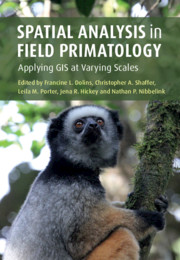Book contents
- Spatial Analysis in Field Primatology
- Spatial Analysis in Field Primatology
- Copyright page
- Dedication
- Contents
- Contributors
- Acknowledgments
- 1 Why Place Matters, and its Use in Primate Behavioral and Ecological Research
- Part I GPS for Primatologists
- Introduction
- 2 Fundamentals of GIS and GPS
- 3 “Next-Gen” Tracking in Primatology
- 4 The Ethical Implications, and Practical Consequences, of Attaching Remote Telemetry Apparatus to Macaques
- 5 Processing Geospatial Data in R
- 6 Estimating Travel Distance and Linearity of Primate Routes
- Part II GIS Analysis in Fine-Scale Space
- Part III GIS Analysis in Broad-Scale Space
- Index
- Plate Section (PDF Only)
- References
4 - The Ethical Implications, and Practical Consequences, of Attaching Remote Telemetry Apparatus to Macaques
from Part I - GPS for Primatologists
Published online by Cambridge University Press: 29 January 2021
- Spatial Analysis in Field Primatology
- Spatial Analysis in Field Primatology
- Copyright page
- Dedication
- Contents
- Contributors
- Acknowledgments
- 1 Why Place Matters, and its Use in Primate Behavioral and Ecological Research
- Part I GPS for Primatologists
- Introduction
- 2 Fundamentals of GIS and GPS
- 3 “Next-Gen” Tracking in Primatology
- 4 The Ethical Implications, and Practical Consequences, of Attaching Remote Telemetry Apparatus to Macaques
- 5 Processing Geospatial Data in R
- 6 Estimating Travel Distance and Linearity of Primate Routes
- Part II GIS Analysis in Fine-Scale Space
- Part III GIS Analysis in Broad-Scale Space
- Index
- Plate Section (PDF Only)
- References
Summary
The use of global positioning system (GPS) units attached to collars is becoming increasingly common in primate studies (Anderson, pers. comm.; Crofoot et al. 2014; Di Fiore & Link 2013; Dore, pers. comm.; Klegarth et al. 2017; Markham & Altmann 2008; Markham et al. 2013; Sprague et al. 2004; Stark, pers. comm.). By deploying GPS collars, researchers can gain enhanced knowledge of primate group whereabouts and overall ranging and landscape use patterns at a high resolution (Crofoot et al. 2014). The utility of these systems has greatly expanded with the increasing spatial accuracy, reliability, and mechanisms (remote data download and drop-off units) of units that facilitate reasonably low impact on study animals (Klegarth et al. 2017; Matthews et al. 2013). While these collars open up new methodological and analytic possibilities for assessing primate ranging patterns and habitat use, they also present a diverse array of technical, structural, and ethical concerns with doing so (Hebblewhite & Haydon 2010; Todd & Shah 2012)
- Type
- Chapter
- Information
- Spatial Analysis in Field PrimatologyApplying GIS at Varying Scales, pp. 64 - 86Publisher: Cambridge University PressPrint publication year: 2021
References
- 2
- Cited by

